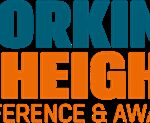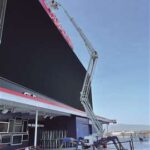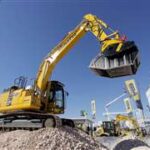JLG’s evolution over the past five decades has truly revolutionized the access industry, turning the company into a global leader in aerial work platforms (AWPs). From a single idea born out of a tragic accident to a wide array of advanced machines, JLG has continually pushed the boundaries of what aerial work platforms can do. Here’s a breakdown of the key milestones throughout the decades that highlight JLG’s innovation and commitment to safety.
The Birth of JLG and the 1970s: Innovation Begins
In 1969, JLG founder John L. Grove’s life-changing experience of witnessing a fatal scaffolding accident led him to innovate a safer alternative for construction crews. The result was the first JLG aerial work platform, which was introduced in 1970, fundamentally changing how work at height was performed. This initial design was the foundation of a company that would go on to pioneer the access industry.
In 1976, JLG introduced its first scissor lift, further expanding the possibilities of safe, elevated work.
The 1980s: Enhancing Maneuverability and Flexibility
JLG continued to innovate in the 1980s by introducing oscillating axles in 1981, improving the maneuverability of both boom and scissor lifts. This added feature allowed for better performance on uneven terrain, offering a more versatile and reliable solution in various work environments.
In 1988, JLG patented the “Extend-A-Reach” feature, which gave users greater flexibility in platform placement, allowing them to access harder-to-reach areas and improving the overall functionality of aerial work platforms.
The 1990s: Expanding Capabilities and Launching Groundbreaking Products
The 1990s saw JLG introduce several industry-firsts that would set the company apart in the access market. In 1991, JLG launched the 150HAX, the industry’s first 150-foot boom, which raised the bar for how high aerial work platforms could reach. The introduction of the mobile vertical lift in 1996 brought even more mobility and efficiency to the field.
In 1999, JLG made a significant leap by unveiling the only fuel-cell-powered boom lift in existence, further aligning with the growing emphasis on sustainability. The same year, JLG expanded its portfolio by acquiring Gradall, adding telescopic material handlers to its product line.
The 2000s: Pushing for Sustainability and Expanding Product Lines
As the new millennium approached, JLG continued to prioritize environmental sustainability and technological advancements. In 2000, they introduced the first 60-foot electric boom lift, a machine that was both environmentally friendly and capable of reaching significant heights.
The company also unveiled SkyWelder® in 2001, the world’s first integrated MEWP (Mobile Elevating Work Platform) welder, showcasing JLG’s focus on developing innovative workstations that offered even more versatility on job sites.
In 2003, JLG expanded further by acquiring Lull® and SkyTrak®, increasing its portfolio of telehandlers. The company was also acquired by Oshkosh Corporation in 2006, creating new synergies that expanded JLG’s reach in the market.
The 2010s: Reaching New Heights and Introducing Smart Technology
By the 2010s, JLG’s commitment to technological innovation was clear. In 2011, the company launched the 1500SJ, the world’s first 150-foot straight boom lift that did not require transportation permits for width and height, offering even more accessibility and ease for transportation.
The 1850SJ, introduced in 2014, became the world’s largest self-propelled boom lift, highlighting JLG’s ongoing drive to provide machines capable of tackling the most demanding tasks.
In 2016, the company previewed the 1500AJP, which would go on to be the tallest articulating boom lift in the world. JLG’s design philosophy during this time focused on maximizing both safety and performance, offering workers increased reach, precision, and efficiency.
2019 saw the launch of the Hi-Capacity HC3™ boom lift line, allowing operators to tackle heavier loads with greater ease, demonstrating JLG’s focus on high-performance equipment that could support a wide range of industries.
The 2020s: Revolutionizing with Smart Technology and Electric Solutions
JLG’s innovations continued into the 2020s, particularly in the area of sustainability and smart technology. In 2021, JLG launched the world’s first all-electric scissor lift, the DaVinci® AE1932, offering an eco-friendly option that significantly reduced emissions and noise, especially in indoor environments.
2022 marked a major milestone with the launch of the 670SJ, the world’s first self-leveling boom lift, which allowed operators to work in more challenging environments with ease and stability.
Later in 2023, JLG introduced the ClearSky Smart Fleet, an IoT (Internet of Things) solution that provided real-time data and analytics, enhancing fleet management capabilities and improving the efficiency of aerial work platforms in the field.
In 2023, JLG further expanded its offerings by acquiring Hinowa, which added tracked boom lifts, mini dumpers, and lift trucks to its product mix. The following year, the company acquired AUSA, adding more equipment to support industries that require rough terrain forklifts and wheeled dumpers.
Looking Ahead: Continuing the Legacy of Innovation
JLG’s legacy of innovation and safety continues as it leads the charge in the access industry. With advancements in electric technology, smart fleet management, and environmental sustainability, the company is poised to redefine what is possible for aerial work platforms in the coming decades.
JLG’s journey from a small idea to a global leader in access solutions reflects the company’s ongoing commitment to improving safety, efficiency, and innovation for workers at height.




